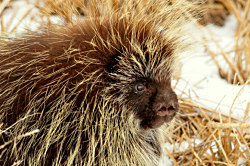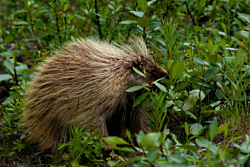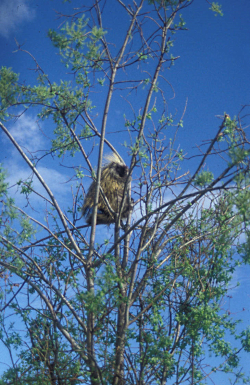
Erethizon dorsatum
Courtesy US FWS
Tom Koerner, photographer
“What is it?!” A gnarly looking beast had cozied up to the window. Its face was a mixture of the grotesque and cuteness. A throng of students rushed to the window. “A porcupine!!” None of the 30 students had seen one in the wild. The questions began. “Can it shoot its quills at you?” “What do they eat?” “Do they bite?” “Do they hibernate”? And so on.

Erethizon dorsatum
Courtesy US FWS
Lisa Hupp, photographer
Unfortunately, most of the porcupines I’ve happened on have been road kills. The others have been in trees where they may spend considerable time eating the bark and stems. A large pile of fecal material may be found at the trees base similar to that of grouse in shape and size.
Another thing I learned is they adore outhouses and will greatly enlarge the holes as whey chew away the salty urine flavored wood. They also have a penchant for ax handles and canoe paddles where salt accumulates from ones laboring hands.
They are long lived- up to 30 years in captivity. I later learned that our Wasatch Mountain Lodge beast had become habituated, a regular visitor looking for a bit of garbage or a treat.
A few other tidbits worthy of note. Porcupines tend to be solitary animals except for when they are mating or caring for their young. They can use caves, old trees, and logs to create their dens, in which they may remain for many days in inclement weather. They possess a wide-variety of calls including moans, grunts, coughs, wails, whines, shrieks and tooth clicking.

Erethizon dorsatum
Courtesy US FWS
Public Domain
Predators are often deterred by the rattling of its hollow quills after which an offensive odor may occur. If the above threats fail, the porcupine will attack by running sideways or backwards while swinging its quilled tail in the direction of the predator.
Their magical quills are being researched by medical scientists to create adhesives, improve needle penetration, and for antibacterial properties. They also had extensive use by Native Americans for exquisite decorative purposes, and their bodies served up a fine meal- with quills removed!
This is Jack Greene and I’m wild about Utah porcupines!
Credits:
Pictures: Courtesy US FWS, Lisa Hupp and Tom Koerner, photographers
Sound: Courtesy
Text: Jack Greene, Bridgerland Audubon Society
Additional Reading:
Can a Porcupine Shoot its Quills? Smithsonian Channel, youTube, March 2, 2015,
Porcupines, Wild Aware Utah, (Utah DWR, Hogle Zoo, USU Cooperative Extension) https://www.wildawareutah.org/utah-wildlife-information/porcupines/
